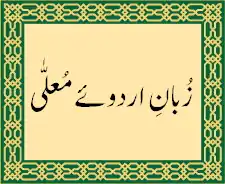Urdu-speaking people
Various Urdu-speaking people are spread across South Asia.[11][12] The vast majority of native Urdu-speakers are Muslims of the Urdu Belt of Northern India, followed by the Deccani people of Southern India (who speak Deccani Urdu) and the Muhajir people of Pakistan.[3]
اردو بولنے والے | |
|---|---|
 The phrase Zaban-e Urdu-e Mualla or "Language of the Exalted Camp" | |
| Total population | |
| 68.62 million[1] | |
| Regions with significant populations | |
| Pakistan, India (diasporic Urdu Belt, a regional belt that consists of Hindi-Urdu belt states such as Uttar Pradesh, Kashmir, west Bihar-mostly Patna and Darbanga, Khandesh, coastal Malwa region, Shimla district and Kangra district and Other Indian states, many speakers live in various cities in South India, mostly Hyderabad), Bangladesh (Dhaka as well as pockets in other parts of the country) and Nepal (Terai) | |
| 50,772,631 (2011)[2] | |
| 30,000,000 (2013)[3][a] | |
| 691,546 (2011)[4] | |
| 397,502 (2013)[5] | |
| 300,000-900,000 (2008)[6] | |
| 269,000 (2011)[7] | |
| 210,815 (2016)[8] | |
| 69,131 (2016)[9] | |
| Languages | |
| Urdu | |
| Religion | |
| Islam | |
Although the majority of Urdu-speakers reside in Pakistan (including 30 million native speakers,[3] and up to 94 million second-language speakers),[10] where Urdu is the national and official language, most speakers who use Urdu as their native tongue live in India, where it is one of 22 official languages.[13]
The Urdu-speaking community is also present in other parts of South Asia with a historical Muslim presence, such as the Bihari community[14] and Dhakaiya of Old Dhaka (who speak Dhakaiya Urdu) in Bangladesh,[15] the Urdu-speaking members of the Madheshi community in Nepal,[16] some Muslims in Sri Lanka[17] and a section of Burmese Indians.[18] In addition, there are Urdu-speakers present amongst the South Asian diaspora, most notably in the Middle East,[19] North America (notably the United States and Canada),[19][20] Europe (notably the United Kingdom),[21] the Caribbean region,[21] Africa (notably South Africa and Mauritius),[21] Southeast Asia (notably Singapore)[22] and Oceania (notably Australia[9] and Fiji).[21] Other communities, most notably the Punjabi elite of Pakistan, have adopted Urdu as a mother tongue and identify with both an Urdu speaker as well as Punjabi identity.[23]
See also
References
- Urdu at Ethnologue (22nd ed., 2019)
- "Census of India 2011: Language" (PDF). Office of the Registrar General and Census Commissioner of India. 2011. Retrieved 28 May 2020.
- Carl Skutsch (7 November 2013). Encyclopedia of the World's Minorities. Taylor & Francis. pp. 2234–. ISBN 978-1-135-19395-9.
- "National Population and Housing Census 2011" (PDF). Central Bureau of Statistics, Government of Nepal. November 2012. Retrieved 19 July 2020. According to this census, 671,851 out of Nepal's 691,546 Urdu-speakers resided in the Terai region. Urdu-speakers comprised 2.61% of Nepal's total population.
- "Detailed Languages Spoken at Home and Ability to Speak English for the Population 5 Years and Over for United States: 2009-2013".
- "Citizenship for Bihari refugees". BBC News. 19 May 2008. Retrieved 19 July 2020.
- "2011 Census: Quick Statistics". Office for National Statistics. Retrieved 11 April 2015.
- "Census Profile, 2016 Census, Canada". Government of Canada, Statistics Canada. Retrieved 6 October 2020.
- Ali, Waqar (23 November 2018). "Find out how many people speak Urdu in your suburb". SBS News. Retrieved 19 July 2020.
- Čedomir Nestorović (28 May 2016). Islamic Marketing: Understanding the Socio-Economic, Cultural, and Politico-Legal Environment. Springer. pp. 142–. ISBN 978-3-319-32754-9.
- Joseph, Ammu (2004). Just Between Us: Women Speak about Their Writing. Women's World, India. ISBN 978-81-88965-15-1.
- Mir, Raza (2014-06-15). The Taste of Words: An Introduction to Urdu Poetry. Penguin UK. ISBN 978-93-5118-725-7.
- Pereltsvaig, Asya (2017-08-24). Languages of the World: An Introduction. Cambridge University Press. ISBN 978-1-107-17114-5.
- Claire Alexander; Joya Chatterji; Annu Jalais (6 November 2015). The Bengal Diaspora: Rethinking Muslim migration. Routledge. pp. 96–. ISBN 978-1-317-33593-1.
- Redclift, Victoria (2013-06-26). Statelessness and Citizenship: Camps and the Creation of Political Space. Routledge. ISBN 978-1-136-22032-6.
- "Madhesh". Unrepresented Nations and Peoples Organization. 2020. Retrieved 16 July 2020.
- Mahroof, M.M.M. (1992). "Urdu in Sri Lanka: Socio-Linguistics of a Minority Language". Islamic Studies. 31 (2): 185–201. JSTOR 20840072.
- Jayati Bhattacharya; Coonoor Kripalani (1 March 2015). Indian and Chinese Immigrant Communities: Comparative Perspectives. Anthem Press. pp. 9, 121–. ISBN 978-1-78308-447-0.
- Ruth Laila Schmidt (8 December 2005). Urdu: An Essential Grammar. Routledge. pp. 23–. ISBN 1-134-71320-7.
- Karen Isaksen Leonard (2007). Locating Home: India's Hyderabadis Abroad. Stanford University Press. ISBN 978-0-8047-5442-2.
- Tej K Bhatia; Ashok Koul (10 November 2005). Colloquial Urdu: The Complete Course for Beginners. Routledge. pp. 1–. ISBN 978-1-134-77970-3.
- Torsten Tschacher (10 November 2017). Race, Religion, and the 'Indian Muslim' Predicament in Singapore. Taylor & Francis. pp. 235–. ISBN 978-1-315-30337-6.
- Singh, Nikky-Guninder Kaur (2012-11-30). Of Sacred and Secular Desire: An Anthology of Lyrical Writings from the Punjab. Bloomsbury Publishing. ISBN 978-0-85772-139-6.
External links
- Alavi, Shams Ur Rehman (Jul 2018). "Census Data on Language Reveals a Surprise about Urdu". The Wire. Retrieved 18 July 2020.
- Daniyal, Shoaib (Jul 2018). "Surging Hindi, shrinking South Indian languages: Nine charts that explain the 2011 language census". Scroll.in. Retrieved 18 July 2020.